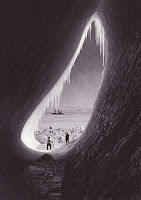Having set off across the disintegrating Ross Sea ice on 24 January 1911, the "Depot Laying Journey" to which Scott had committed the company was making slow but steady progress. He reported from their second camp on 28-29 January 1911 that they had reached the Great Barrier of the Ross Ice Shelf. They had covered roughly 18 miles with their massive loads and would dedicate the coming days to portaging all of it up to the Ice Shelf. The Depot Team consisted of: 12 men, 8 ponies, 26 dogs - hauling 5,538 pounds of gear and necessities as far as "Cache 1".
These supplies were augmented with others brought as far south through
McMurdo Sound as the "Glacier Tongue" by the
Terra Nova, which was moving well through the softened, summer ice. For all this work the ponies were paired and attached to one of four sledges. Scott's journal entry from 24 January 1911 contains a detailed manifest, listing the more than 600 pounds loaded onto each of these sledges. (
Journals, p. 107-108, Carroll &
Graf [1996]). Scott also recorded the extent of the men's gear. Each wore: vest and drawers, woollen shirt, jersey, balaclava, wind suit, two pairs of socks, and ski boots. Each carried the following spare gear: 2 pairs under socks, 2
pairs outer socks, 1 pair hair socks, 1 pair night socks, 1
payjama jacket, 1
payjama trousers, 1 woollen
mitts, 2
finnesko, and skein. Each man was allowed two pounds of discretionary items. (
Journals, p. 108, Carroll &
Graf [1996]). Cherry-Garrard described the existential debates that surrounded the fateful choices the men would make in utilizing those two pounds. "Many were the arguments," Cherry-Garrard said, "as to the relative value of a pair of socks or their equivalent in tobacco." (
Apsley Cherry-Garrard,
The Worst Journey in the World, p. 108, Carroll &
Graf [1989]). Cherry-Garrard's invoice contains some interesting details left out of Scott's. For example, he notes that the men were keen to have large
safety-pins on hand "with which to hang up our socks." (
Apsley Cherry-Garrard,
The Worst Journey in the World, p. 108, Carroll &
Graf [1989]).
The Company hauled the last of the designated supplies off the
Terra Nova on 26 January 1911 and Scott - a Royal Navy Captain and thoroughgoing seaman - bid the ship and its crew goodbye (it would depart to New Zealand to avoid the coming, brutal, south-polar winter and return again in 1911 with new supplies) with the kind of heartrending warmth, affection, and gratitude so in keeping with his character. Scott reported that he thanked the ship's crew for their work, and concluded that "they have behaved like bricks and a finer lot of fellows never sailed in a ship." (
Journals, p. 109, Carroll &
Graf [1996]). The
Terra Nova left under the command of Lt. Harry
Pennell. Cherry-Garrard made the poignant note that "Four of that Depot party were never to see these men again, and
Pennell, Commander of the
Queen Mary, went down with his ship in the
battle of Jutland." (
Apsley Cherry-Garrard,
The Worst Journey in the World, p. 110 [1989]).
And the debate over ponies and dogs was now being waged in practice. Scott reported that, in the portage over the Barrier to the Ice Shelf on 27 January 1911, the pony sledges were smoothly hauling upwards of 900 pounds while the dogs were managing only 500 pounds "at a snail's pace." (
Journals, p. 110, Carroll &
Graf [1996]). Whatever prejudices Scott might have entertained ahead of the expedition were being confirmed on both sides of the debate.









